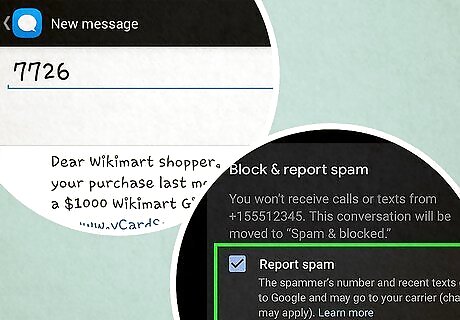
views
- If you respond to a text scammer, they may send or sell your number to other scammers. Avoid clicking on suspicious links and sharing personal info.
- To scare a scammer, you could waste their time with silly responses, pretend to be an automated messenger, or resend them the messages they sent you.
- Report all text scams to the Federal Trade Commission’s Report Fraud site, filter messages from unknown numbers, and avoid opting in on company sites.
Is it wise to scare text scammers?

It's best to avoid engaging with scammers. Although it can be entertaining (and sometimes hilarious) to give scammers a taste of their own medicine, replying to their texts can invite more trouble than it may be worth. A single response can be enough to prove that your number is real, and scammers can potentially sell your information to other groups, inviting even more unwanted messages—getting your personal information may just be a nice bonus.
Ways to Reply to a Text Scammer

Waste their time by pretending to go along with their scam. Don’t go all the way and send them money or click on links or anything, but play along to waste as much of their time as possible. Ask them questions, make plans you’ll never fulfill, and pretend to fall for their scam. Just make sure you don’t give them any personal information! You can also mess with scammers by introducing ridiculous elements into the conversation, like asking them to communicate using a secret code made entirely of cereal brands.

Pretend to be an automated messenger. One of the most satisfying ways to shut down a text scammer is to scam them right back—with a pretend automated message. As a bonus, you can also say that they’ll be “billed” or “charged” for your services to really mess with their heads. Here are some funny templates you can use: “Thank you for subscribing to Random Bird Facts. Each morning you’ll receive a new cool fact about birds! You will be charged €10.” “You have successfully subscribed to Weird Bear Pictures of the Day! Congratulations! $20 will be billed to your account.” “Congratulations! You have successfully subscribed to Hilarious Knock Knock Jokes. To unsubscribe, text STOP.” “Hello, thank you for registering this number to Daily Inspirational Quotes. Your number will be charged 10 Pesos/day. Text C to Cancel.” If they try to text “STOP” or “Cancel,” try replying with a message like “Sorry, you have entered an invalid code. Please try again.”

Copy and paste their own message and send it to them. While this might not waste as much of their time, it may confuse them enough to get them to take you off their list. Alternatively, you could send them a link to your online store or an affiliate link. Just make sure that none of your personal information is attached to whatever link you’re sending them to.
Staying Safe When Messaging a Text Scammer

Avoid clicking any links or attachments. When texting back scammers, be careful to avoid clicking on links, downloading PDFs, or opening attachments. These could potentially have viruses or other malicious software attached to them that could steal your information or harm your devices.

Use a fake name and avoid sharing personal information at all times. By openly sharing things like your pet’s name, the schools you attended, your family members’ names, or your birthday, you could give the scammer all they need to guess your passwords or answer security questions. If you want to mess with your scammer, make sure you don’t provide any real information.
Reporting and Avoiding Text Scams

Watch out for common texting scams. Often, a scammer will pretend to be a person you know or a well-known company and send you fake websites or ask for your personal information. If you’re not sure how to identify a fake text message, here are some common texting scams to look out for: The text pretends to be from the U.S. Postal Service, FedEx, or UPS claiming that there’s an issue with your delivery. If you recently posted your resume on a job site, you may get a text or message where they claim to offer a job or send you checks in the mail so you will deliver your money to a secure address for them to pick it up. They pretend to be a bank and ask you to call a number about suspicious activity on your accounts or ask you to reply “YES” or “NO” to verify whether a transaction was authorized. The text claims to be from a well-known company like Amazon, offering a free gift card or reward. They may claim to be the IRS, reference things like “stimulus payments,” or talk about personal tax issues like bills or refunds. They pretend to be one of your relatives or friends and ask for emergency cash.

Block the sender and text their message to SPAM (7726). You can report a text scammer to your wireless service provider by forwarding unknown unwanted numbers to the number 7726. On an iPhone device, press and hold on the message and click on “more…” Click on the forward arrow on the bottom right, enter “7726,” and hit the send arrow. When your service provider sends you a message, reply and include the suspicious number. On an Android device, press and hold the message and select “forward message.” Once the message is selected, click the forward arrow in the upper right and enter “7726” in the field. When your service provider sends you a message, reply and include the suspicious number.

Report any scam texts or calls to the FTC’s Report Fraud site. Report all of the messages you receive to the Federal Trade Commission’s Report Fraud website. Once you click “Report Now” on the front page, follow the steps to give them all the information needed to investigate and bring a case against the scammer. Anything you can provide about your experience can be helpful. You can paste the text of your messages into the Comments field of your report. Take screenshots of the messages before you block and delete the number in case law enforcement asks you for them in connection with an investigation.

Filter out messages from unknown numbers. On iPhone and Android, you can turn on your messaging filters so you won’t receive texts from numbers you don’t know, which can help eliminate the problem at its source. On an iPhone device, open Settings > “Messages,” scroll down to “Message Filtering,” and turn on “Filter Unknown Senders.” While this filter is on, you’ll only be able to see unknown senders when you go to “Filters” > “Unknown Senders.” On an Android device, open the Messages app, tap the three dots inside the search bar, go to “Settings,” then “Spam Protection,” and then “Enable Spam Protection.” The slider should turn blue. Make your phone number private on social media accounts like Facebook. On Facebook, click on your public profile in the top right. Click “About,” then “Contact and Basic Info.” Next to your mobile number, choose the icon to the left of the pencil and select “Only me.” You can also take off your number from public sites. Search your number on the internet to see where else it may be publicly listed, and remove it from any sites you see.

Opt out of receiving marketing calls and texts. To cut down on spam texts, opt out of promotional materials by unchecking the boxes on company websites when you provide your email or phone number. You can also add your number to the National Do Not Call Registry so official telemarketers don’t call or text you. Telemarketers will often get your number from data providers who sell it to them. If you’ve ever called a toll-free number, given your phone number to a company, or ordered products online, it’s possible that your number might have been sold to telemarketers. To combat receiving scam messages, try using an app like Google Voice or DoNotPay to generate a burner number you can use on company websites instead of your personal number.

















Comments
0 comment